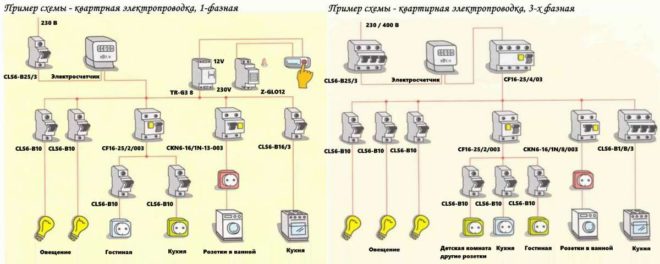How to replace the wiring in the apartment with your own hands

During major repairs, many decide to immediately change the wiring in the apartment. There are many reasons for this. Firstly, if your house was built a long time ago, then the entire electrical network that was laid in it is already outdated, both physically and morally. Secondly, before, aluminum wires were mainly used for wiring in Khrushchev or Stalin's houses, and this metal, as you know, is highly corroded, and becomes very fragile during operation. Thirdly, modern electrics are characterized by high power of household appliances. About 20-30 years ago, the project laid a load of about 3 kW for each apartment, now this figure has increased significantly.
So, as you can see, replacing the wiring is not a whim and a whim, but an urgent need. Let us consider in detail how to carry out this process, where to start, which part of the old wiring must be changed, and in which cases it can be left.
Content
Main stages
You must immediately decide whether you can replace the wiring in the apartment with your own hands or whether you will invite professional electricians. Keep in mind that electrical work is the most difficult and voluminous part of a home renovation.
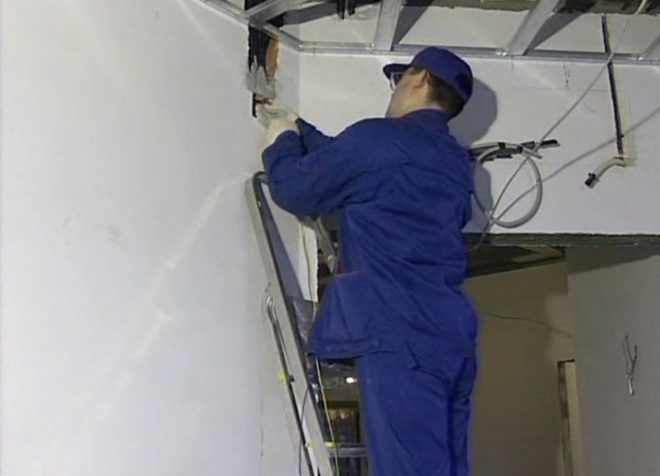
Material costs will be correspondingly high. If you have no limitations in funds, then it is better to invite specialists.
Replacing electrical wiring in an apartment with your own hands is based on three main components.
- Definitely, all aluminum wires must be replaced with copper ones. We have already mentioned that metal is susceptible to corrosion, besides, it has a soft structure, it is squeezed out from under the screw terminals, its soldering is a complicated and expensive process, and aluminum strands weaken over time. All this can ultimately lead to unreliability of contact connections.
- It will be necessary to switch from the previously used circuit with a dead-grounded neutral (TN-C) to a circuit with protective earthing of consumers (TN-C-S). Power supply according to the previous TN-C scheme was used in the Soviet Union forcibly, because there was massive electrification, electrical networks were very long and, moreover, there was an acute shortage of non-ferrous metals. Since the end of the 90s, the transition to power supply according to the TN – C – S scheme began, which ensures the safe operation of consumers regardless of the general state of the network.

- It will be necessary to mount the group connection of consumers with separate branches, while earlier wiring was used by branching from the main apartment panel through junction boxes.
According to the new scheme, you will have a separate branch from the common shield, made with a single piece of cable, for each group of consumers.
Drawing up a diagram
At the initial stage, all work will be of a theoretical nature, that is, it will be necessary to clearly define the scheme and the amount of materials.
Before changing the wiring in an apartment, draw up a diagram on which to depict the plan of the living space. It will be most convenient to take it from the technical passport and redraw it on paper in a box.
An example of drawing up a diagram and further editing on video:
In this drawing, display where all large-sized furniture will stand (so as not to plan the installation of sockets behind it) and household appliances (in this case, on the contrary, the sockets must be mounted side by side). Determine the location of the switches, as a rule, they are mounted near the front door to the room.Mark where you will need sockets, except for the places of installation of stationary household appliances (refrigerator, oven, air conditioner), that is, it is advisable to decide in advance where you will put or hang your TV, stereo system, computer.
Draw the locations of the lighting elements - sconces, bedside lamps, floor lamps.
Keep in mind that powerful household appliances, such as a water heater, an electric stove, a washing machine, a dishwasher, or a “warm floor”, should not be connected to the mains through sockets, but with a separate line from an individual machine.
Transferring a layout plan to walls
Now transfer the drawn up scheme to the walls of your apartment, you will still make repairs, so you can still draw on the wall surfaces. Mark the locations of outlets, switches, lighting fixtures and junction boxes (these are usually located at the entrance to the room). There are no strict sizes for their placement, but try to adhere to the following recommendations:
- The switches are located at a height of 0.8 to 1.5 m from the floor level.
- The same parameter for outlets varies from 0.3 to 1 m, everything here will depend on your interior. The main thing is that it would be convenient for you to use them later.
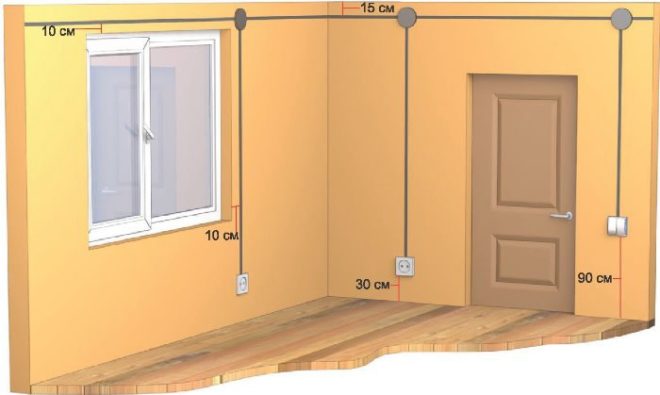
- In the bathroom, it is advisable to do without installing sockets. If there is an urgent need for this, then it must be connected through a residual current device (RCD). The distance from the outlet to the bathroom elements (sink, bath, shower) must be at least 0.6 m.
- Junction boxes are located at a distance of 15-20 cm from the ceiling surface. Do not forget to take this into account if in the future you plan to lower the ceiling (make it stretch or from plasterboard sheets).
From boxes to switchgear, draw the paths for the wires.
These routes must be strictly vertical or horizontal, no zigzags or oblique lines are allowed, do not try to save on materials like that.
Necessary materials
Now, based on all the work done, you can determine the amount of materials that you need to change the wiring in the house. Count how many junction boxes, outlets, and switches you have mapped. If the wiring is of a hidden type, then for each switching device you will also need a socket box. Measure the amount of wire you need along the drawn routing lines using a tape measure. Be sure to take it with a margin for cutting at the joints (6-10% of the total length).

For DIY wiring, choose a three-core wire or a copper cable. A section of 1.5 mm will be enough for the lighting network2, for rosette groups - 2.5 mm2, for powerful electrical consumers - 4 mm2.
We advise you to purchase a high-quality German conductor with the NYM marking, with polyvinyl chloride insulation. Of domestic cable products, the VVG brand conductor is in the greatest demand. Also, for laying the conductors, you will need a corrugated pipe, and in the case of an open type of wiring, cable channels. It is better to buy metal corrugation, as in case of an emergency, polyvinyl chloride can decompose and release toxic substances.
The choice of cable and machines on video:
It is imperative to protect the home electrical network from overloads, short circuits and current leaks, so automation is indispensable. It will be necessary to install RCDs and circuit breakers (or combined options - differential circuit breakers). They are selected according to their rated current, depending on the load that will be present on the protected line. Let's give you an example of what machines are approximately needed for an ordinary three-room apartment:
- general introductory machine - 40 A;
- for a socket group - 25 A;
- for lighting - 16 A;
- for powerful consumers - by 32 A.
When choosing machines, give preference to the leaders in the market of electrical products - the firms "Legrand" and "ABB".
Junction boxes are of two types and they differ from each other only in design.
Boxes of square and rectangular shape are more spacious, and round boxes are much more convenient to install.
Drilling a round hole in the wall for such a box is much easier than hammering a square or rectangular niche.
Be sure to choose sockets with grounding. If there are small children in the house, then special devices with protective curtains will be needed (so that the child cannot pick out foreign objects inside). Pay special attention to the rated current for which the switching device is designed, otherwise problems may arise when connecting powerful consumers.
Instruments
Before you change the wiring in the apartment, you will need to stock up not only with materials, but also with a fairly large number of tools. If you do not have all the necessary devices, then it may still make sense to turn to professionals. Check out the list of everything you need to install a new wiring, and then make a decision for yourself.
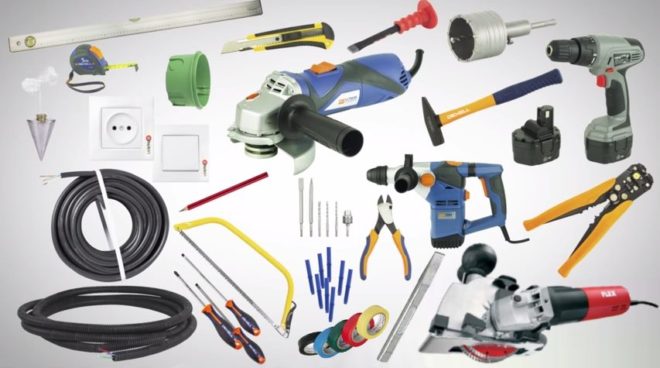
The ideal option is to rent a power tool.
- A hammer drill and a set of drills for concrete (as well as a concrete drill, core drill and chisel). This tool is required for mounting holes for sockets, switches and boxes.
- Level, plumb line and cord for marking the laying of wires.
- A grinder (and a circle on a stone to it) or a wall chaser for making furrows in the walls for wires.
- A spatula and plaster of paris (or alabaster) for filling the strobes after the wires have been laid in them.
- An assembly knife or a special device for removing the insulating layer on the wires (stripper).
- Pliers, a set of flat and cross-head screwdrivers, side cutters.
- Soldering iron with solder and rosin for connecting wires.
- Indicator screwdriver for phase and zero detection.
- Long carrying. During repair work, you will use a temporary hut to power the power tool, and its length should be sufficient to the most remote rooms and corners.
Dismantling old wiring
Replacing the electrical wiring in an apartment with your own hands begins, first of all, with a complete de-energization of the room. Disconnect the input circuit breaker for the apartment and make sure that there is no voltage.

It is easiest to start dismantling the old wiring with switches and sockets, remove them, thereby freeing the ends of the wires. Open the junction box covers and disconnect all wiring boxes. Now, gently pulling on the old cable, release it from the putty strobes. Finding wires in wall surfaces will help a special device - a hidden wiring indicator, some in this case even use a metal detector.
If in some place it is not possible to dismantle the cable, then do not try too hard, do not destroy the walls. Leave the problematic section of the wiring in the old furrow, just carefully insulate its ends on both sides.
Installing new wiring
It should be said right away that it is not recommended to partially change the wiring. If you have already undertaken to repair again, then do it everywhere. The only case when it is allowed to replace only part of the home electrical network if a wire break has occurred somewhere and it is necessary to fix it.
And now the very process of installing a new wiring. Perhaps, in some of the rooms, the path of the wire from the box to the sockets and switches will remain the same. This is good, you will not need to hammer new grooves.
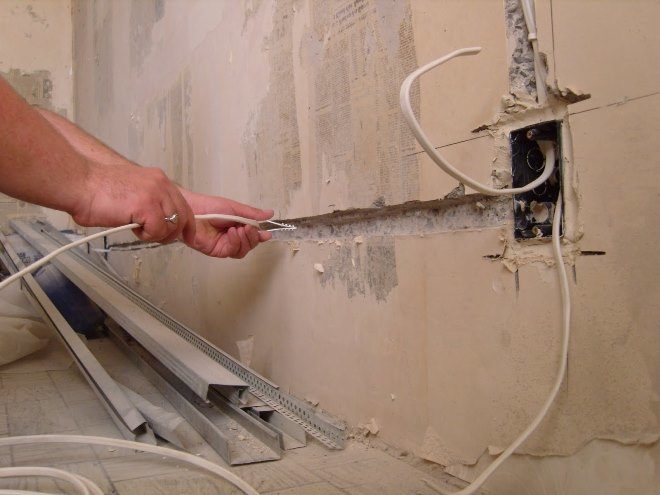
In the event that you have planned to do everything completely differently, start with the holes for switching devices and junction boxes, and already between them make grooves for laying wires.
Note! Since you have already dismantled the old wiring, and you are just laying the new one, there will be no voltage at all in the apartment. To connect the power tool, use a temporary hut, which can be thrown from the input panel, or negotiate with your neighbors to power them from them through a carrier.
Cut the required pieces of conductors and corrugated pipe. Tighten the wires into the corrugation and place them in the grooves made. Remember to leave the connection tips on both sides. Install the socket outlets in the holes made, tighten the wires in them and now you can fix them with alabaster mortar.
You do not need to cover the strobes with a continuous layer of alabaster; it is enough to grab them every half a meter.
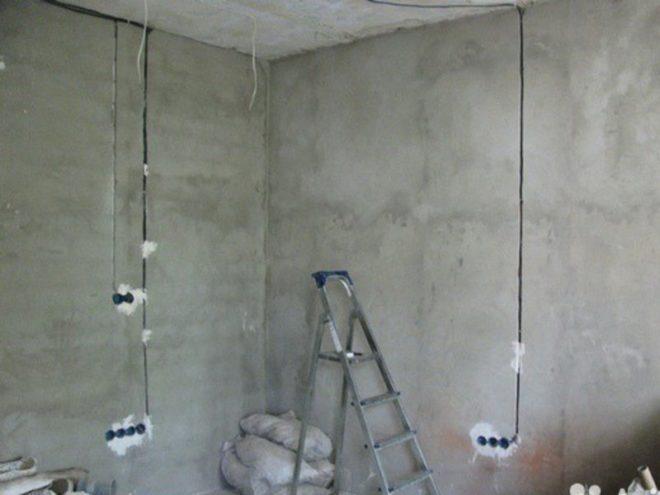
Connect wires to sockets and switches, install switching devices in socket outlets. Now make all the necessary connections in the junction boxes.
Keep in mind! If you want to make lighting on a balcony or loggia, then you do not need to pull a whole branch there, the lamps are connected through the sockets of neighboring rooms.
Be sure to test the new electrical wiring before finishing work on the apartment.
If there are doubts between partial and complete replacement of electrical wiring, then the answer can be found in the video:
We have explained how to replace the old wiring, there are no particular difficulties here. Those who have ever been involved in electrical work and are well versed in electrical engineering will cope on their own. But sometimes it's better not to take risks, and at least consult with professionals.


